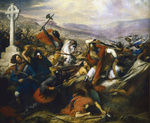École polytechnique de l'université de Tours
2002 establishments in FranceEducational institutions established in 2002Engineering universities and colleges in FranceGrandes écolesTours, France

École polytechnique de l'université de Tours (Polytech Tours) a French engineering College created in 2002.The school trains engineers in five majors : Planning and environmental engineering Computer Science Electronics and Electrical Power Systems Mechanics and Systems Design Industrial data.Located in Tours, Polytech Tours is a public higher education institution. The school is a member of the University of Tours.
Excerpt from the Wikipedia article École polytechnique de l'université de Tours (License: CC BY-SA 3.0, Authors, Images).École polytechnique de l'université de Tours
Avenue Jean Portalis, Tours
Geographical coordinates (GPS) Address Nearby Places Show on map
Geographical coordinates (GPS)
| Latitude | Longitude |
|---|---|
| N 47.36458 ° | E 0.68475 ° |
Address
Bâtiment Portalis (Polytech Tours - Informatique)
Avenue Jean Portalis
37000 Tours
Centre-Val de Loire, France
Open on Google Maps









